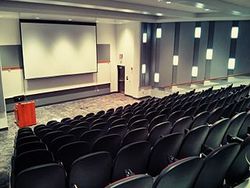Must be a popular lecturer
 Suppose a lecture hall has a rectangular array of chairs with
rows and
columns. Suppose further that there are precisely
girls seated in each row and precisely
boys seated in each column.
Suppose a lecture hall has a rectangular array of chairs with
rows and
columns. Suppose further that there are precisely
girls seated in each row and precisely
boys seated in each column.
If exactly chairs are empty then find the minimum possible value of
Details and Assumptions :
- A maximum of one person per chair is allowed.
Image Credit: Wikimedia Hobiecat93
The answer is 1176.
This section requires Javascript.
You are seeing this because something didn't load right. We suggest you, (a) try
refreshing the page, (b) enabling javascript if it is disabled on your browser and,
finally, (c)
loading the
non-javascript version of this page
. We're sorry about the hassle.
Since there are 1 9 girls seated in each row there are 1 9 r chairs occupied by girls, and since there are 1 5 boys seated in each column there are 1 5 c chairs occupied by boys. There are a total of r c chairs in the lecture hall, so with 1 4 empty chairs we can form the equation
1 9 r + 1 5 c + 1 4 = r c ⟹ 1 5 c + 1 4 = r ( c − 1 9 )
⟹ r = c − 1 9 1 5 c + 1 4 = c − 1 9 1 5 c − ( 1 5 ) ( 1 9 ) + ( 1 5 ) ( 1 9 ) + 1 4 = 1 5 + c − 1 9 2 9 9 .
Now r must be an integer so c − 1 9 must divide 2 9 9 . Since 2 9 9 = 1 3 ∗ 2 3 , we can have c − 1 9 equal 1 , 1 3 , 2 3 or 2 9 9 . This gives us four possible pairs ( c , r ) , namely
( 2 0 , 3 1 4 ) , ( 3 2 , 3 8 ) , ( 4 2 , 2 8 ) , ( 3 1 8 , 1 6 ) .
The resulting products are 6 2 8 0 , 1 2 1 6 , 1 1 7 6 , 5 0 8 8 , respectively, and so the desired minimum of r × c is 1 1 7 6 .